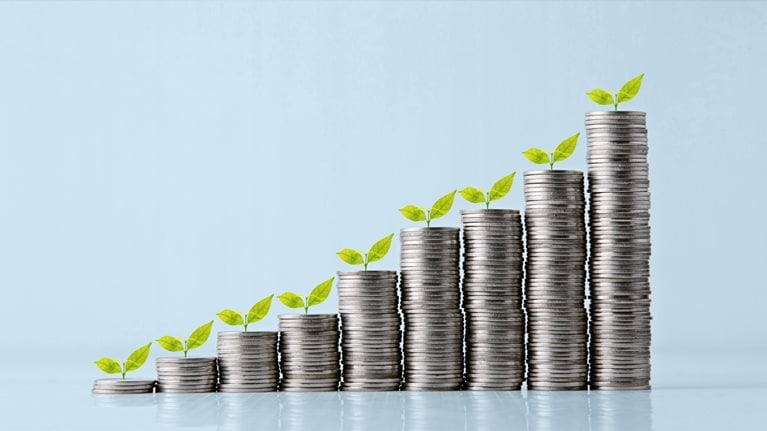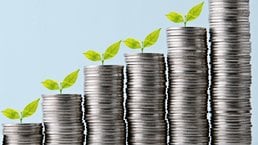
Growth is good: personal growth, portfolio growth, and economic growth too. But measuring economic growth for an entire country is a lot harder than knowing whether you have more money in your bank account today than you did yesterday. You’ve probably seen articles about GDP and other economic statistics; these are tools from the realm of macroeconomics to measure whether an economy is growing or shrinking.
Understanding whether an economy is getting bigger or smaller is important not only to economists but also to public- and private-sector leaders, as well as to individuals. That’s because economic growth usually indicates that people and businesses are earning and spending more and generally feeling better off. If it’s stalled, or if an economy is contracting, companies will spend less and maybe even cut jobs. People will earn and spend less, too, leaving them feeling worse off.
How is economic growth measured?
Economic growth is difficult to measure accurately. Counting the number of televisions manufactured in a country is one thing. But once we get into services or intangible products such as intellectual property or research output, things get a little muddled. As a result, economists have traditionally turned to gross domestic product (GDP) as an indicator of an economy’s growth or recession. As we’ll see, this is an imperfect index metric by which to judge an economy’s overall health.
What is GDP?
GDP is the monetary value of goods and services a country produces in a certain period. Traditionally, GDP has been considered the best indicator of a country’s economic growth because it accounts for the country’s entire economic output, including goods and services sold both domestically and internationally.
Economists distinguish between nominal and real GDP. These are calculated slightly differently: real GDP takes into account the effects of inflation, whereas nominal GDP does not. Real GDP is generally considered a more accurate gauge.
In recent years, economists have questioned whether GDP is the best measure of growth. GDP was never intended to be an index metric to represent the overall performance of an economy. And increasingly, GDP seems less and less reflective of economic realities. For one thing, analysis by the McKinsey Global Institute has shown that in recent decades the historical link between the growth of net worth and the growth of GDP has been disrupted. Economic growth in advanced economies over the past two decades has been tepid at best, while balance sheets and net worth have tripled in size.
GDP seems even less useful when you think about everything it doesn’t take into account, for instance, all the things we use and do, especially online, that we don’t pay for—such as maps, email, messaging, video conferencing, and more. Nor does GDP take into account unpaid labor, including child or elder care and domestic chores. Finally, GDP doesn’t include the environmental costs of production or, crucially, disposal. It boils down to this: if something doesn’t have a price attached, it doesn’t get measured in GDP. And ultimately, that means an inaccurate measure of an economy’s growth and overall health.
Learn more about our Financial Services and Public & Social Sector practices, and the McKinsey Global Institute.
What are some alternative metrics indicating economic growth?
A more holistic measure is needed to get a better sense of an economy’s growth and prospects. This measure needs to account for domestic labor, free online goods and services, and the environmental costs of doing business. It also needs to account for intangible assets such as software and other intellectual property. The COVID-19 pandemic seems to have accelerated the shift toward dematerialization in economies. Dematerialization refers to a general reduction, over time, in the amount of raw materials—or tangible assets—needed for economic functions. Tangible assets are things such as cement, telephone poles, copper wire, and tractors. Intangible assets, on the other hand, are things such as intellectual property, software programs, data sets, and other digital assets. Over the past 25 years, the investment share of intangibles has increased by 29 percent.
“You wouldn’t run a company just by looking at cash flow and profit and loss,” says economist Diane Coyle on McKinsey Global Institute’s Forward Thinking podcast. “You need to understand what’s happening to the balance sheet, as well. . . . It’s just the same for any national or subnational economy, you need to know what the assets are that you have and how they will generate prosperity in the future.”

Looking for direct answers to other complex questions?
But what measurements should populate this balance sheet? Some economists suggest using the Human Development Index, which tracks key dimensions of human achievement, including life expectancy and quality of life, education levels, and standard of living. Others suggest the Inclusive Wealth Index, which measures wealth using countries’ natural, manufactured, human, and social capital.
But perhaps, according to Coyle, we should look beyond the numeric metrics used in the past. The pandemic has shone a light on uneven distributions of unpaid work happening in the home. And the climate crisis is causing increasingly frequent wildfires, droughts, and other unpredictable climate events, as well as biodiversity loss, which could hit agricultural productivity and food supply chains.
“It’s not just about measurement,” Coyle says. “It’s about how you think about things.”
What is productivity?
There are several types of productivity in economics. Labor productivity is pretty much the same as productivity at your desk. It’s a measure of how much gets done according to a specific unit, like one hour’s work, or one dollar. For countries, it’s frequently calculated as a ratio of GDP per total hours worked. Labor productivity growth is crucial to increased wages and standards of living, and it helps increase the purchasing power of consumers.
Economists measure other types of productivity, too. Capital productivity is a measure of how well capital is used to generate output such as goods and services. (Capital productivity and labor productivity are frequently considered together as an indicator of a country’s overall standard of living.) And material productivity is measured as the amount of economic output generated per unit of materials consumed.
Learn more about our Operations practice.
What’s the relationship between economic growth, productivity, and a changing labor market?
Over the past 50 years, the world economy expanded sixfold and average per capita income almost tripled. These unprecedented results were powered by rapid population growth—which expanded the number of workers—and a healthy increase in labor productivity.
But looking ahead, this unprecedented economic growth will slow dramatically if we don’t improve productivity. That’s because population growth is slowing, which means the labor force is shrinking relative to the overall population. If there are fewer overall workers contributing to the economy, each worker’s productivity will have to increase for GDP growth to stay on track. McKinsey Global Institute research on the future of productivity and growth after the COVID-19 crisis, focused on the United States and Europe, found that some firms responded boldly to the pandemic, acting in ways that have the potential to increase productivity in the years ahead. If corporate action broadens, particularly in large sectors, and demand is robust, there is potential to accelerate annual productivity growth by about one percentage point by 2024. But the economic shock of the pandemic and the response of companies could exacerbate long-run structural drags on demand. It is notable that about 60 percent of estimated productivity potential comes from companies prioritizing efficiency over output growth—through automation, for instance. If productivity gains aren’t reinvested in growth that drives jobs and incomes, we risk a widening inequality gap.
Learn more about our Public & Social Sector practice.
How can economic growth help increase racial economic parity?
Economic growth can create opportunities to right historical wrongs, if policy makers and business leaders foster more inclusive economies and societies. McKinsey research shows that existing economic inequality, especially in the United States, demonstrates the economic growth potential for African Americans, Latinos, and other traditionally marginalized groups.
McKinsey research has demonstrated an estimated $220 billion annual disparity between wages earned by Black Americans in practice and what those wages would be in a scenario of full parity, with Black representation across occupations matching the Black share of the population, and the elimination of racial pay gaps. Achieving full parity would boost total Black wages by 30 percent and draw approximately one million additional Black workers into employment. Just by addressing the wage disparities described in our research, an estimated two million Black Americans would enter the middle class for the first time.
Racial parity in the labor market could mean a potential 40 percent rise in Black consumer spending. The combination of racial income parity and expanded access to goods and services in Black communities could unlock some $700 billion in value, to be shared by companies and Black households.
Latinos in the United States reckon with similar inequalities. McKinsey research has shown that Latinos are collectively underpaid by $288 billion a year. If full income parity were achieved, Latinos could spend an extra $660 billion annually, Latino-owned businesses could generate an extra $2.3 trillion in total annual revenue, and 735,000 new businesses could be created, supporting 6.6 million new jobs. Finally, Latinos’ annual flow of net wealth from one generation to the next could be $380 billion higher.
McKinsey research findings suggest several starting points to address inequities of the labor market:
- diversify hiring and promotions, plus improve the workplace experience for different groups of employees
- strengthen educational pathways
- improve the quality of jobs disproportionately held by Black and Latino workers today
- prepare for the future of work by creating opportunities for upskilling or education for Black and Latino workers whose jobs are subject to disruption by automation and business-model disruptions
- help people, including formerly incarcerated individuals, excluded from work enter the labor market
- consider how to expand opportunities across industries and geographies
What is sustainable, inclusive growth?
Rapid economic growth over the last 50 years has helped sustain and create jobs around the world, which propels consumer spending and creates a tax base to support infrastructure, healthcare, and social services. As a result, in recent decades hundreds of millions of people have lifted themselves out of poverty and lived healthier, longer lives than ever before. But as we’ve seen, there is much progress to be made toward inclusive economies and societies.
As businesses emerge from COVID-19 crisis, the challenge is clear: How can we build a future that delivers sustainable, inclusive growth? The first step is setting down some basic definitions.
- In growth, we include the ambition of increased prosperity and well-being, including economic-profit growth for companies, GDP growth for nations, and measures such as life satisfaction for citizens derived in part from dignity of work. (We also recognize that measurable definitions of well-being are still evolving.)
- In inclusion, we consider equality of opportunity and broad-based progress of outcomes for all—especially sufficiency of living standards—and the narrowing of inequalities among genders, ages, ethnicities, family backgrounds, and places of residence.
- In sustainability, we aim for environmental resilience, which starts with reducing climate risk but also includes much broader preservation of natural capital as well as intergenerational fairness, all considered in terms of economic and societal costs and benefits.
Done right, these three goals can be a self-reinforcing combination. Here’s how:
- Growth supports inclusion by creating meaningful jobs, lifting incomes, and correcting labor-market imbalances.
- Growth enables sustainability by encouraging investment.
- Greater inclusion and sustainability promote growth through new demand and investment opportunities.
- India could more than quadruple its renewable energy capacity by 2030, potentially generating $90 billion in GDP and supporting around two million jobs in 2030.
- Globally, more inclusive healthcare could add $12 trillion to global GDP growth in 2040.
- Sustainability reinforces both inclusion and growth through two cross-cutting benefits of the energy transition: lower costs that make energy more accessible, and more resilient and productive lives.
But achieving this virtuous circle will require addressing three main counteracting forces:
- Rising inequality. Growth affects inclusion through skill-biased inequality, exacerbated by COVID-19 and the rise of the knowledge-based economy. As things stand now, almost all growth in labor demand could occur in high-wage occupations.
- Unchecked resource consumption and emissions.
- In the energy transition, developing countries and those with large fossil fuel sectors could be disproportionately affected, as could lower-income households.
To address the challenges of achieving sustainable, inclusive growth, business leaders and policy makers will need to learn the lessons of the pandemic. Multiple experiments are needed, as well as unprecedented speed in scaling successful ones, and broad participation across sectors and actors.
For more in-depth exploration of these topics, see McKinsey’s “Employment and Growth,” “Strategy & Corporate Finance Insights,” “Risk & Resilience Insights,” “Sustainable, Inclusive Growth,” and “Future of America” collections. Learn more about the McKinsey Global Institute—and check out McKinsey Global Institute–related job opportunities if you’re interested in working at McKinsey.
Articles referenced include:
- “Can long-term global growth be saved?,” McKinsey Global Institute, January 1, 2015, James Manyika, Jonathan Woetzel, Richard Dobbs, Jaana Remes, Eric Labaye, and Andrew Jordan
- “The economic state of Black America: What is and what could be,” McKinsey Global Institute, June 17, 2021, Shelley Stewart III, Michael Chui, James Manyika, JP Julien, Dame Vivian Hunt, Bob Sternfels, Jonathan Woetzel, and Haiyang Zhang
- “The economic state of Latinos in America: The American dream deferred,” December 9, 2021, Lucy Pérez, Bernardo Sichel, Michael Chui, and Ana Paula Calvo
- “The future of work after COVID-19,” McKinsey Global Institute, February 18, 2021, Susan Lund, Anu Madgavkar, James Manyika, Sven Smit, Kweilin Ellingrud, and Olivia Robinson
- “Is GDP the best measure of growth?,” McKinsey Global Institute, January 1, 2015, Richard Dobbs, James Manyika, Jaana Remes, and Jonathan Woetzel
- “Our future lives and livelihoods: Sustainable and inclusive and growing,” October 26, 2021, Bob Sternfels, Tracy Francis, Anu Madgavkar, and Sven Smit
- “Will productivity and growth return after the COVID-19 crisis?,” McKinsey Global Institute, March 30, 2021, Jan Mischke, Jonathan Woetzel, Sven Smit, James Manyika, Michael Birshan, Eckart Windhagen, Jörg Schubert, Solveigh Hieronimus, Guillaume Dagorret, and Marc Canal Noguer



